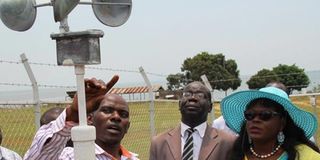Government acquires Shs6 billion weather-reading machines

Mr Moses Tumusiime, a senior meteorologist at the Directorate of Water Resource Management (Left), explains how readings are taken off an Anemometer to the UNDP Resident Representative, Ms Rosa Malango, (Right) and Mr Wilson Kwamya, the Team Leader, Growth and Poverty Reduction, at UNDP in Uganda. Photo by Paul Tajuba
What you need to know:
- The equipment have been used to establish 20 automatic weather stations and five all-in-one Total Solutions Automatic Weather Stations, with a lightening detection system installed in Napak, Kaliro, Kotido, Sironko and Agago districts.
- The UN Resident Coordinator, Ms Rosa Malango said information on weather patterns and climate change should be communicated in a simple way to understand messages.
Entebbe. The Uganda National Meteorology Authority (UNMA), has acquired automatic weather reading equipment that will enable the Authority gather and dispatch faster information to avert the effects of natural disasters.
The gadgets worth $2m (Shs6.7b) donated by United Nations Development Programme (UNDP) under the Strengthening Climate Information and Early Warning Systems (SCIEWS) will be shared by UNMA with the Department of Water Resource Management (DWRM), all based in Entebbe.
The equipment includes; pluvio precipitation gauges for measuring the amount and intensity of rain and hail; hydra probe for the simultaneous measurement of soil moisture, salinity, and temperature and meteorological balloons for high altitude measurement of atmospheric pressure, temperature, humidity and wind speed using a radiosonde.
Other gadgets included; General Packet Radio Service (GPRS) quads, solar radiometer sets, computers, servers, solar panels, telemetry gateway, meteorological thermometers, 16 hydrological - Automatic Water Level Monitoring Station (AWLS) and five automatic weather sensors to be mounted on telecommunications masts.
The UN Resident Coordinator, Ms Rosa Malango said information on weather patterns and climate change should be communicated in a simple way to understand messages.
“They (gadgets) have improved weather reporting and connected Uganda with regional monitoring systems,” Ms Malongo, said, adding: “However, these achievements notwithstanding, we still have a challenge of ensuring that information generated from these systems are utilised to influence policy and to inform the public and private sector to plan their productive activities accordingly.”
Stations set up
The equipment have been used to establish 20 automatic weather stations and five all-in-one Total Solutions Automatic Weather Stations (TSAWS), with a lightening detection system installed in Napak, Kaliro, Kotido, Sironko and Agago districts.
“The five special stations with a high precision lightning detection were installed in the five districts because of the high incidence in those areas,” said Mr Pascal Onegiu Okello, the Project Manager SCIEWS.
UNMA executive director, Mr Festus Luboyera said that monitoring of the weather patterns, gathering of information and dispatching it had been boosted. “We give out the information but how many people read it and use it effectively?” Mr Luboyera said.
The commissioner water resources, Mr Nerbert Wobusobozi, said his department has faster means of monitoring the water levels of Lake Victoria.
Ms Caroline Nakalyango, a senior water officer (information management) said the equipment has enabled the department get “real time information” to study trends.
“In that past one would read (recordings) and someone drives here after a month to pick information. Now its real time,” Ms Nakalyango said while explaining the improvement information flow.




